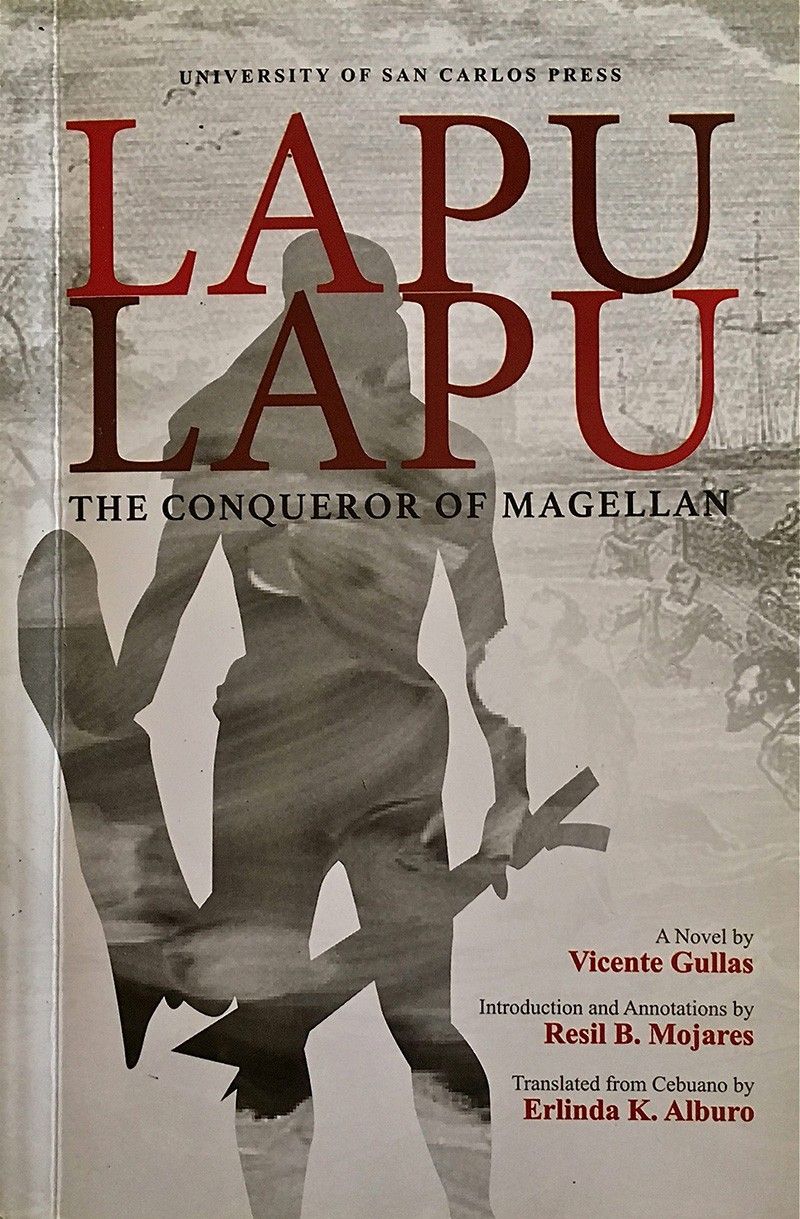Excessive invention as historical fiction


Launched early in May was Lapulapu: The Conqueror of Magellan, a novel by Vicente Gullas, translated from Cebuano by Erlinda K. Alburo, with a critical introduction by Resil B. Mojares, and published by University of San Carlos Press.
Gullas wrote the novel in 1938. While entertaining (in an antic manner), it’s a rather strange fictional biography that merges moralistic teachings with a near-mythic tale of Lapulapu’s growth as a young boy of athletic prowess and dauntless courage.
The embroidered history has a young Portuguese creole, Pedro Pellecer, coming to Mactan from Mindanao, bringing along a caged lion and gorilla, whose beastly powers are often tested by Lapulapu. Pedro also proselytizes (a quarter of a century ahead of Magellan) and manages to have the young “Lapu” and his older sister Mingming “acknowledge the Bathala of the Christians.”
At one point Mingming is said to be 16 while Lapu is nine. Pages later, she is eight while he’s four. The Mactanons entertain themselvs with contests of physical strength, often involving men versus animals. Apes and wild carabaos are thrown into the fray. Sharks and crocodiles inhabit the sea together, while a kangaroo metaphor finds surprising application. Among the place names are Santa Rosa and San Nicolas, years before Magellan’s ships arrive.
When they finally do, in Chapter 20 (out of 28), Magellan plays no more than a cameo role. He discovers that the Pedro who had preceded him was an uncle. Planning a pre-emptive attack on rival Cebu chieftain Humabon, Lapulapu tells a follower: “We shall depart tonight at 10:30.” It’s not supposed to be funny (or to make us wonder if it were an Apple Watch the hero consulted).
For all his prowess as a warrior, and his earlier challenge to go mano-a-mano, it’s not Lapulapu who finally engages Magellan in mortal combat.
“But the leader of Mactan did not know that, like him, the Spanish navigator had the heart of a lion, the quickness of a tiger, and the courage of a true hero. The first native to face Magellan almost lost his head; the second had an ear and an arm cut off; and the third fell as soon as the Spaniard’s weapon pierced his chest. But a merciless arrow hit the unprotected thigh of Magellan. … When he turned around and saw that all his companions were already safe in the boats, he straightened and fought until the end. But no one in the world can endure being ganged up on by three men such as Dosdos, Bitadlok and Bali Alho. Magellan fell, like a true hero, without tasting cowardice. In this fight, the world lost its most famous explorer, and the leader, the light and companion of those first Spaniards that spread the faith and ideals of Christ in the East.”
As for Lapulapu, he rejects Humabon’s offer of ransom for Magellan’s body, and convinces him instead to finish off the foreigners at a banquet in their honor. The Spanish ships depart. Lapulapu and his men invade Cebu to punish Humabon’s ally Zula, before he gets to marry off his son Sawili to Humabon’s daughter Nimfa, thus uniting the people of Mactan and Cebu.
The Annotations section mentions that Gullas acknowledges certain textbooks of Philippine history as his sources, as well as conversations with fellow Cebuanos that presumably provided snippets of oral history. Also acknowledged is “the novel Slaves of Love, or Princess Nida (1934) by Vicente Salumbides, a prewar Filipino filmmaker (who learned his craft in Hollywood), considered the progenitor of the ‘Hollywoodization’ of Philippine movies. Salumbides may have influenced how Gullas composed his book less as a novel than a scene-by-scene movie scenario filled with episodes of sentimental love and physical combat.”
My reading habits often have me hopscotching through a volume, so it wasn’t before I experienced the flavor of the novel that I got back to the part of Mojares’ introduction where he writes on Gullas — and says that the novel “was written for the purpose of values formation through the medium of a quasi-historical, literary entertainment.”
Further: “As a novel, Lapulapu has few literary merits. Its plot is loose, repetitive, and episodic (in the manner of popular, serial ficton at the time)… Transposing early twentieth-century realities to sixteenth-century Cebu, the novel is filled with anachronisms, incongruities, and contradicions. Freely drawing from history and oral lore, Lapulapu is an excessively fictional invention.”
Mojares presents a thorough review of a myriad of accounts, from primary and secondary documents to modern historians to oral history (a “scattered, fragmented tradition” in lieu of “a native tradition of literacy”). Surviving oral lore is mostly legend, inclusive of “subordinate chiefs similarly gifted with extraordinary powers,” amulets, magical pestles as weapons, and curses that turn rivals into stone, etc.
“… (W)hat we have in the Mangan/Lapulapu stories is a case where a ‘hero of history’ (the historical Lapulapu) is transmuted into the ‘hero of tradition’ (the mythical Lapulapu)…” Then there are “Popular histories (that) freely combine oral history, folklore, fiction, and modern historiography, often without distinguishing among these modes of representing the past.”
“Nationalist myth-making” also resurrected Lapulapu.
“No Filipino hero has been the subject of as much fantasy and error as Lapulapu. Such is the process by which Lapulapu has joined the pantheon of national heroes.”
Once again, we are thankful to Mojares for the breadth and depth of his scholarship, its characteristic acuity and clarity of writing.
By the by, on July 30-31, to be held at Novotel Hotel in Araneta Center is “Bridging Worlds, Illumining the Archive: An International Conference in Honor of Professor Resil B. Mojares.” It’s organized by Philippine Studies: Historical and Ethnographic Viewpoints; School of Social Sciences, Loyola Schools, Ateneo de Manila University; and Southeast Asian Studies Center for Southeast Asian Studies, Kyoto University.



















